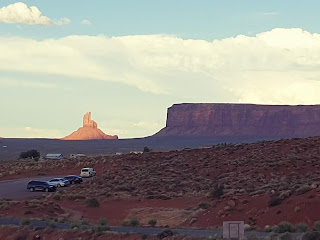Some thoughts on my month-long ham radio drive across America in July 2019.
Hi Y'all....from June 18 to July 18 2019, the xyl and I drove across the USA. We visited the following states:
CA
AZ
NV
UT
NM
TX
OK
MO
IN
IL
KY
WV
VA
MD
DE
PA
NJ
NY
5000 miles of driving in a nice Toyota Camry.
Whereas our trip wasn't entirely about ham radio, I did work HF as much as possible.
Firstly, I purchased an FT-840 from a guy who turned out to be a bit of a sneak in that he assured me that the rig has the VCXO high accuracy crystal oscillator. I bought the rig and had it shipped to my sister-in-law in Los Angeles. As it turns out, the rig did not have the VCXO-4, and was plagued by shifting frequency issues that are possible with the FT-840. I did a little on the spot surgery on the existing oscillator board and got the rig to be mostly stable.
Everywhere we went I attempted to haul up my little wire antenna and work some CW. The best locations for HF were Santa Fe, NM, and Lexington, KY.
Homemade paddle. A plastic cutting board using part of a hacksaw blade. Super-light and works
Operating from Monument Valley, UT....no noise here
Standin' on the corner in Winslow, Arizona
Batter Up! Working HF from Kentucky
So here are a few observations of HF in the USA.
1. Noise is unpredictable. Some places were surprisingly quiet and others that should have been quiet were plagued by noise.
2. The bands should not be dead. I was a little surprised by the lack of activity on HF. CW on 20m was fairly inactive. I had trouble really wrapping my head around this, since from my home QTH in Israel, there is a lot of activity from Europe all day long. I had to ask myself if the USA and the EU are using the same ionosphere for propagation. Being that it is likely that we do transmit and receive using the same variables, then why is activity so light in the USA.
Keep in mind that my data is anecdotal since I am basing this on my results as I traveled from California across the USA to NY/NJ. I can say that in Santa Fe, NM and Lexington, KY I did have good results from my wire and 100 watts.
3. I saw one tower on the road during the whole drive. The tower was about 70 feet and had a few yagis and other antennas on it. I saw it off of rt. 64 in Virginia. Frankly I was surprised that in 5000 miles of driving I only saw one tower.
4. No visit to the ARRL Headquarters. Unfortunately, I ran out of steam by the time we got to NJ, and so a 5 hour roundtrip to Newington was just impossible. Sleep was required.
Overall, I can say that HF activity seemed slim in the USA. I read recently that someone had posted (somewhere) that we all need to get on the bands and call CQ. This seems to be absolutely the answer, even in these low cycles. Compared to the EU, activity seems to be just sad in the USA, and there is no reason that it should be, other than the fact that operators from the EU are constantly getting on and calling CQ. In light of that, I would really encourage USA hams to push for more calling CQ and listening and calling on HF, not just using FT8. Learn CW even if it means getting on at 5 wpm to start.
The National Aquarium in Baltimore, MD. A dolphin making waves.





3 comments:
Glad you had a great time!
The dolphins look lovely!
There are a few different types of ham radio gifts that you can give. One option is to give a ham radio kit, which will allow the recipient to build their own radio. Another option is to give a pre-built radio, which is ready to use out of the box. You can also give ham radio accessories, such as an antenna or a power supply. Whatever you choose, make sure it is something the recipient will appreciate and use.
Post a Comment